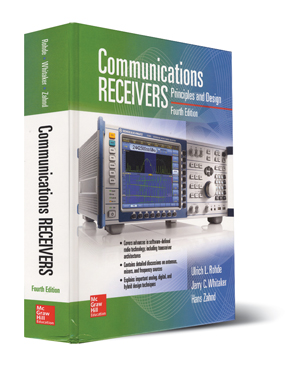 This new edition of the classic, “Communications Receivers,” was prompted by the maturation of software-defined radio (SDR) technology over the past decade. Enabled by improvements in component technology and software — the increasing sampling rates of analog-to-digital and digital-to-analog converters and the processing power of field programmable gate arrays — SDRs are no longer just an academic subject. SDR systems are now widely fielded, the mobile phone perhaps the most topical example.
This new edition of the classic, “Communications Receivers,” was prompted by the maturation of software-defined radio (SDR) technology over the past decade. Enabled by improvements in component technology and software — the increasing sampling rates of analog-to-digital and digital-to-analog converters and the processing power of field programmable gate arrays — SDRs are no longer just an academic subject. SDR systems are now widely fielded, the mobile phone perhaps the most topical example.
This fourth edition of “Communications Receivers” reflects this transition, enhancing the treatment of direct digital conversion and systems on a chip (SoC) and removing analog topics that are no longer relevant to a nearly all-digital world. Nonetheless, the fundamental analog principles and technologies are thoroughly addressed. In 11 chapters spanning almost 700 pages, the authors discuss basic radio considerations, radio receiver characteristics, receiver system planning, receiver implementation, SDR principles and technologies, SDR transceivers, antennas, mixers, frequency sources, ancillary receiver circuits and performance measurements. The chapter on SDR principles and technologies describes various architectures: classic heterodyne, direct-conversion, digital IF, direct-sampling, broadband and multicarrier receivers and discusses the associated RF front-end design considerations. A commercially available wideband monitoring receiver is presented in the appendix to illustrate the implementation of a SDR.
Ulrich Rohde and Jerry Whitaker wrote the prior three editions, beginning in the 1980s. To best address the technology shift to SDR, they recruited Hans Zahnd to join them and contribute his extensive experience with SDR receiver and transmitter systems. This latest edition continues the excellent technical discussion of communications receivers and will be a worthy reference for the next decade.
To order the book:
Published by McGraw-Hill Education
www.mheducation.com
ISBN: 978-0-07-184333-1
700 pages
$140, Print
$140, eBook
